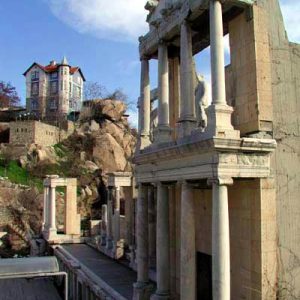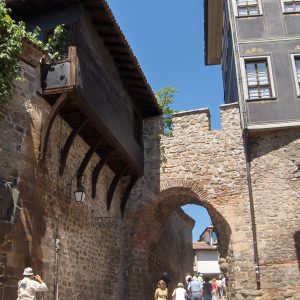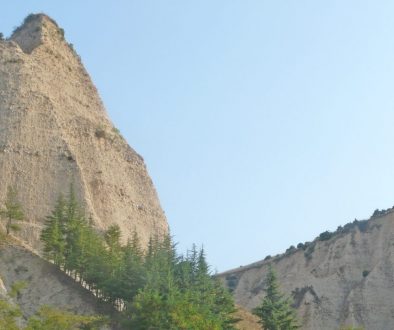Plovdiv
The city of Plovdiv has a population of 376 276 and is situated in the western part of the Upper Thracian Plain 160 m above sea level. It is located 150 km away from Sofia, 102 km away from Smolyan. It ranks second by area and by the number of population after the capital city.
Historic records of the most ancient inhabitants of this area date from the Neolithic and Bronze Age. Around 1000 B.C. Thracians founded the ancient settlement of Eumolpias. In 342 B.C. the town was conquered by Philip of Macedonia, renamed to Philippopolis and turned into a fortress.
 Under Roman rule the city turned an important economic, cultural and political centre. It became known under the name of Trimontium.
Under Roman rule the city turned an important economic, cultural and political centre. It became known under the name of Trimontium.
The following two centuries were marked by the barbarian invasions of Huns and Goths who repeatedly pillaged and burned down the city.
In the 6th century A.D. Slavs settled on these lands and named the city Puldin. It became part of the Bulgarian state during Khan Krum‘s reign in 815 A.D.
 From that time up until Bulgaria fell under Ottoman rule (1364) Plovdiv (now going by that name) was the target of many invasions, conquered in turn by Bulgarians, and Byzantines. Ottoman registers mention the city under the name of Filibe. Left in the outer bounderies of the Ottoman Empire, the city gradually lost its strategic position and went on the decline.
From that time up until Bulgaria fell under Ottoman rule (1364) Plovdiv (now going by that name) was the target of many invasions, conquered in turn by Bulgarians, and Byzantines. Ottoman registers mention the city under the name of Filibe. Left in the outer bounderies of the Ottoman Empire, the city gradually lost its strategic position and went on the decline.
During the Revival period it regained its statute as a large economic and cultural center. After the Berlin Congress Plovdiv was declared the capital of Eastern Rumelia.
 The seven hills, narrow streets and architectural complexes in the Old Plovdiv create its unrivalled atmosphere and unique appearance. The visitor should not miss the grand Sahat Tepe with its 16th-centry clock tower, the Monument of Alyosha; Djendem Tepe. The Maritsa River, one of Bulgaria’s biggest rivers, flows through the city. In addition to its remarkable Old Town, Plovdiv is also famous for hosting the annual International Plovdiv Fair.
The seven hills, narrow streets and architectural complexes in the Old Plovdiv create its unrivalled atmosphere and unique appearance. The visitor should not miss the grand Sahat Tepe with its 16th-centry clock tower, the Monument of Alyosha; Djendem Tepe. The Maritsa River, one of Bulgaria’s biggest rivers, flows through the city. In addition to its remarkable Old Town, Plovdiv is also famous for hosting the annual International Plovdiv Fair.



